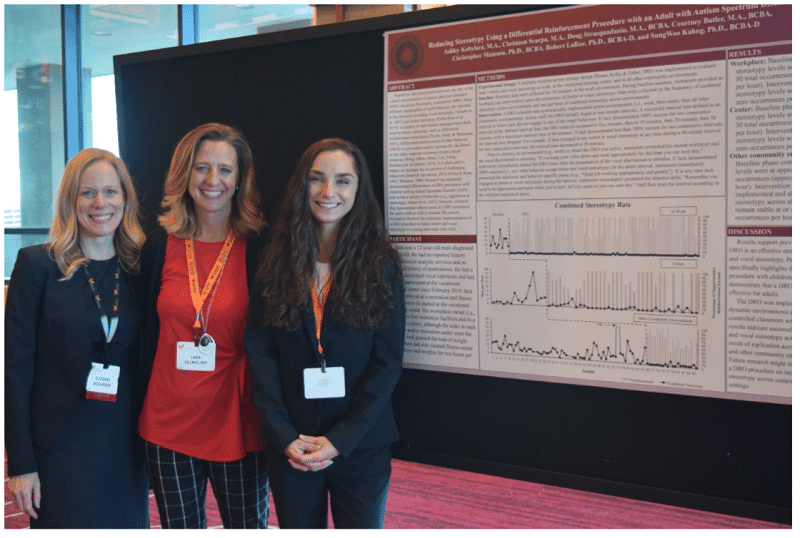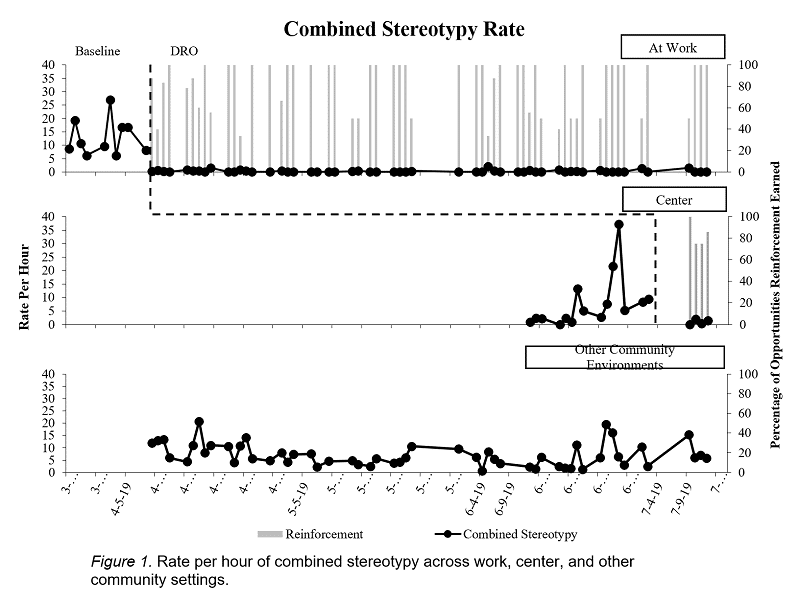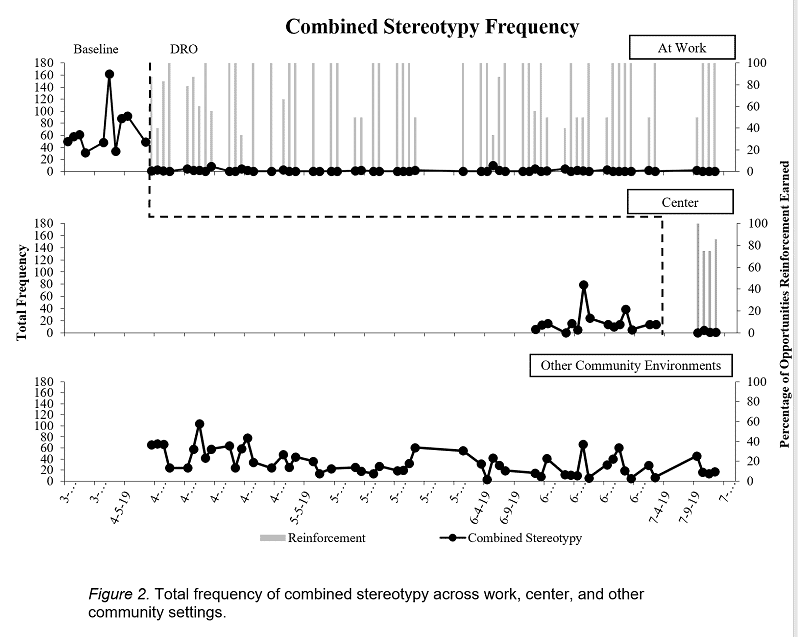Adult Autism Research: A Note of Congratulations
David Celiberti, PhD, BCBA-D
Executive Director
 Consistent with our mission to promote the dissemination of evidence-based autism treatment, ASAT was very proud to sponsor a research poster session at Autism New Jersey’s 37th Annual Conference this past October. As was the case last year, one component of the poster session focused exclusively on research involving adults with autism. Given that the majority of people with autism are adult-age and that there is a relative dearth of research focusing on this ever-increasing segment of the autism community, we want to thank Autism New Jersey as well as Rutgers Center for Adult Autism Services, for providing this platform to showcase and nurture the efforts of researchers carrying out research to improve the lives of adults with autism.
Consistent with our mission to promote the dissemination of evidence-based autism treatment, ASAT was very proud to sponsor a research poster session at Autism New Jersey’s 37th Annual Conference this past October. As was the case last year, one component of the poster session focused exclusively on research involving adults with autism. Given that the majority of people with autism are adult-age and that there is a relative dearth of research focusing on this ever-increasing segment of the autism community, we want to thank Autism New Jersey as well as Rutgers Center for Adult Autism Services, for providing this platform to showcase and nurture the efforts of researchers carrying out research to improve the lives of adults with autism.
There were 23 approved poster submissions this year and five qualified for the adult research contest (i.e., had a participant 21 years old or older or studied ways to train staff who work with adults).
Several individuals graciously served as judges in this year’s competition:
- Tracy Kettering, PhD, BCBA-D; Bancroft & Rider University
- Robert LaRue, PhD, BCBA-D; Rutgers University
- Christopher Perrin, PhD, BCBA-D; Georgian Court University
- Eric Rozenblat, PhD, BCBA-D; Institute for Educational Achievement
- Samantha Volpe, PhD, BCBA; Elwyn New Jersey
Autism New Jersey took great care to ensure that all identifying information was redacted and judges affiliated with the organizations of the authors did not evaluate those particular submissions.
We would like to take this opportunity to congratulate Ashley Kobylarz from the Rutgers Center for Adult Autism Services who is the winner of the 2019 Adult Research poster session and to share her work with our readers. As the winner, Ashley received a $500 prize. We appreciate all of the research poster participants, and in particular, Ashley, for conducting research with adult participants. We would like to share her paper below:
Reducing Stereotypy Using a Differential Reinforcement Procedure with an Adult with Autism Spectrum Disorder
Ashley Kobylarz, MA, Christeen Scarpa, MA, Doug Stracquadanio, MA, BCBA, Courtney Butler, MA, BCBA, Christopher Manente, PhD, BCBA, Robert LaRue, PhD, BCBA-D, and SungWoo Kahng, PhD, BCBA-D
Abstract
Repetitive and stereotyped behaviors are one of the central characteristics of autism spectrum disorders (ASD; American Psychiatric Association 2000). Many different topographies of such behaviors are reported in the literature including vocal stereotypy (Ahearn et al. 2007) and motor stereotypy (Della Rosa et al, 2015). A number of intervention strategies have been used to reduce stereotypy, such as stimulus control procedures (Della Rosa, Fellman, DeBiase, DeQuinzio, & Taylor, 2015), response interruption and redirection (Ahearn, Clark, & MacDonald, 2007; Ahrens, Lerman, Kodak, Worsdell, & Keegan, 2011), and differential reinforcement procedures (Taylor, Hoch, & Weissman, 2005). Differential reinforcement of other behavior (DRO) is a procedure used to increase the likelihood of any other response occurring except a target response (Wong, Odom, Hume, Cox, Fettig, Kucharczyk, & Schultz, 2014). It is often used to reduce or eliminate the occurrence of challenging behaviors (Jessel & Ingvarsson, 2016; Poling & Ryan, 1982; Whitaker, 1996). Research has repeatedly demonstrated effectiveness of DRO procedures with children with an Autism Spectrum Disorder (ASD) and across a variety of behaviors (e.g., aggression or stereotypy; Ahearn et al., 2007). However, research that demonstrates effectiveness of a DRO procedure for adults with an ASD is limited. The current evaluation involved the systematic implementation of a DRO procedure to reduce motor and vocal stereotypy in a young adult male with ASD. The DRO was implemented across three environments (i.e., his workplace, the vocational training center, and other community environments) using a multiple-baseline design. Baseline data yielded high rates of combined motor and vocal stereotypy across all conditions. Combined motor and vocal stereotypy levels were reduced to at or near zero once the DRO was implemented in the workplace environment, while baseline data for combined stereotypy remained at similar levels in other community environments and the vocational training center. Once the DRO was implemented in the center environment in addition to the workplace, combined motor and vocal stereotypy levels were reduced to at or near zero while baseline data in all other community environments remained at similar results. The DRO will be implemented in all other community environments once experimental control is demonstrated in the center environment.
Method
Participant and Setting
Jack was a 22-year-old male diagnosed with ASD. He had no reported history of contact with behavior analytic services and no reported history of medications. He had a highly developed vocal repertoire. He had been a participant at the vocational training center since February 2019. The vocational training center is a program designed to support participants in the community and in their workplace(s) during 9:00 a.m. – 3:30 p.m. hours, with some exceptions based on individual need. Participants spent little time at the center because programming occurred in the community. For example, Jack spent approximately 1-1.5 hours per day in the center versus approximately 5-6 hours at work and in the community. Jack was employed at a recreation and fitness center since he started at the vocational training center. His workplace varied (i.e., there are four recreation facilities and five fitness centers), although the tasks in each fitness and/or recreation center were the same. Jack greased the rods of weight machines and also cleaned fitness center machines and weights for two hours per day.
Materials
Materials required for this intervention were edible reinforcers for successful intervals and a timer to indicate to instructors the remaining duration of intervals.
Procedure
A brief multiple-stimulus without replacement (MSWO) preference assessment was conducted daily upon his arrival to the vocational training center. Jack was instructed to select what he would prefer to earn that day. Selections were a variety of edibles (e.g., small pieces of candy or pieces of chocolate). Once Jack made a selection, his typical workday would begin. This included, but was not limited to, riding a public bus to a destination (e.g., work), going to work, eating lunch, participating in a leisure activity, and riding a public bus back to the center. Sessions were conducted across environments.
Baseline. Baseline data were collected for 10 sessions in the work environment. During baseline sessions, instructors provided no feedback (see intervention) upon the occurrence of motor or vocal stereotypy. Data were collected on the frequency of combined stereotypy across environments and rate per hour of combined stereotypy across environments.
Intervention. A DRO schedule was systematically implemented across environments (i.e., work, then center, then all other community environments). Across staff, the DRO initially began at one-minute intervals. A successful interval was defined as an interval in which Jack did not engage in any of the target behaviors. If Jack demonstrated 100% success for two consecutive intervals at the defined interval time, the DRO interval increased to five minutes, then to 10 minutes, then 20 minutes, then 30 minutes, with a maximum interval time of 60 minutes. If Jack demonstrated less than 100% success for two consecutive intervals, the interval time dropped. For example, if Jack engaged in any motor or vocal stereotypy at any time during a 60-minute interval for two consecutive intervals, the interval time decreased to 30 minutes.
Prior to entering an environment (e.g., work) in which the DRO was active, instructors presented his chosen reinforcer and the vocal discriminative stimulus, “If you keep your voice down and work appropriately for this time you can earn this.” Instructors immediately started the DRO timer after the presentation of the vocal discriminative stimulus. If Jack demonstrated 100% success (i.e., any other behavior except motor and vocal stereotypy) for the entire interval, instructors immediately presented the reinforcer and behavior-specific praise (e.g., “Great job working appropriately and quietly”). If at any time Jack engaged in motor or vocal stereotypy during the interval, instructors immediately presented the stimulus delta, “Remember you need to be appropriate and quiet while you’re here, let’s try again so you can earn this.” Staff then reset the interval according to the criterion mentioned above.
Dependent Variables
The dependent variables for this intervention were Jack’s motor and vocal stereotypy. Although combined, both were separately defined. Motor stereotypy was operationalized as any movement emitted that was not contextually relevant to the setting or included in a directive, and making faces in a context that it is not contextually appropriate to do so. Vocal stereotypy was operationalized as any instance of a vocal word or sound emitted, which was not directed at a person, and/or was not contextually relevant to a current situation. Additionally, any conversation or vocalizations that were not contextually relevant to the setting he was in or directed at another person were included.
Experimental Design
A multiple-baseline across settings design (Roane, Kelly, & Fisher, 2003) was implemented to evaluate Jack’s motor and vocal stereotypy at work, at the vocational training center, and in all other community environments.
Discussion
Results support previous findings in that a DRO is an effective strategy to reduce motor and vocal stereotypy. Previous research specifically highlights the success of a DRO procedure with children, and our results demonstrate that a DRO procedure is effective for adults.
The DRO was implemented in highly dynamic environments (i.e., these were not controlled classroom settings). However, our results indicate successful reduction of motor and vocal stereotypy across environments and results are expected to replicate in other community environments. Future research might include an evaluation of a DRO procedure on motor and vocal stereotypy across controlled versus dynamic settings.


References
American Psychiatric Association. (2013). Diagnostic and statistical manual of mental disorders (5th ed.). Washington, DC: APA.
Ahearn, W. H., Clark, K. M., & MacDonald, R. P. F. (2007). Assessing and treating vocal stereotypy in children with autism. Journal of Applied Behavior Analysis, 40, 263-275.
Ahrens, E. N., Lerman, D. C., Kodak, T., Worsdell, A. S., & Keegan, C. (2011). Further evaluation of response interruption and redirection as treatment for stereotypy. Journal of Applied Behavior Analysis, 44, 95-108. doi.org/10.1901/jaba.2011.44‐95
Della Rosa, K., Fellman, D., DeBiase, C., DeQuinzio, J. A., & Taylor, B. A. (2015). The effects of using a conditioned stimulus to cue DRO schedules. Behavioral Interventions, 30, 219-230. doi.10.1002/bin.1409
Jessel, J., & Ingvarsson, E. T. (2016). Recent advances in applied research on DRO procedures. Journal of Applied Behavior Analysis, 49, 991-995. doi:10.1002/jaba.323
Poling, A., & Ryan, C. (1982). Differential reinforcement of other behavior schedules: Therapeutic applications. Behavior Modification, 6, 3-21. doi:10.1177/01454455820061001
Roane, H. R., Kelly, M. L., & Fisher, W. W. (2003). The effects of noncontingent access to food on the rate of object mouthing across three settings. Journal of Applied Behavior Analysis, 36, 579-582. doi:10.1901/jaba.2003.36-579
Taylor, B. A., Hoch, H., & Weissman, M. (2005). The analysis and treatment of vocal stereotypy in a child with autism. Behavioral Interventions, 20(4), 239-253.
Whitaker, S. (1996). A review of DRO: The influence of the degree of intellectual disability and the frequency of the target behavior. Journal of Applied Research in Intellectual Disabilities, 9, 61-79. doi:1360-2322/96/010061
Wong, C., Odom, S. L., Hume, K., Cox, A. W., Fettig, A., Kucharczyk., & Schultz, T. R. (2014). Evidence-based practices for children and young adults with autism spectrum disorder. Chapel Hill: Frank Porter Graham Child Development Institute, Autism Evidence-Based Practice Review Group, The University North Carolina.

